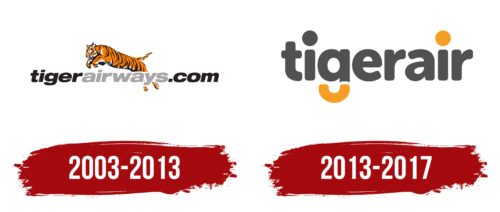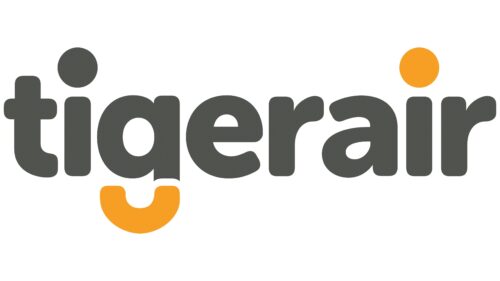The Tigerair logo is a brilliant example of how a brand can use its animal symbol. The emblem reflects the main qualities of a tiger: strength, courage, and self-confidence. This emphasizes the company’s drive for outstanding results and leadership in the aviation industry.
Tigerair: Brand overview
Tigerair, a pioneering budget airline, has left its indelible mark on Southeast Asia’s skies. With Singapore Changi Airport as its hub, the airline provides affordable and convenient flights to various destinations, including Bangladesh, Taiwan, China, and India.
Founded in 2003, Tigerair’s mission was clear: to offer budget travelers in Southeast Asia affordable air travel options.
In 2010, Tigerair took a significant step towards growth and financial stability by listing on the Singapore Stock Exchange; by creating Tiger Airways Holdings, the airline sought to attract investors and strengthen its position in the highly competitive aviation industry.
In October 2014, Tiger Airways Holdings transformed, becoming part of the respected SIA Group. This acquisition has ensured Tigerair’s continued success and expansion in the aviation industry.
Tigerair’s extensive network covers various regional destinations in Southeast Asia, including popular tourist destinations, vibrant economic centers, and emerging markets. The airline has flown to Malaysia, Indonesia, Thailand, Vietnam, Philippines, Bangladesh, Taiwan, China, India, and other countries, making it easy to experience the vibrant culture and scenic landscapes.
Although Tigerair ceased operations in 2017, its legacy as a pioneering budget airline in Singapore and Southeast Asia lives on.
Meaning and History
What is Tigerair?
Tigerair, officially known as Tiger Airways Singapore Pte Ltd, was a budget airline headquartered in Singapore. It was founded as an independent organization in 2003 and specialized in providing affordable air travel to regional destinations in Southeast Asia, Bangladesh, Taiwan, China, and India, using Singapore’s Changi Airport as its central hub. In 2010, the airline entered the financial markets and was listed on the Singapore Stock Exchange under the name Tiger Airways Holdings. A significant event occurred in October 2014 when SIA Group, one of the leaders in the global aviation sector, acquired a majority stake in parent company Tiger Airways Holdings, effectively turning it into a subsidiary. This merger marked a strategic change in the airline’s structure and management, paving the way for new opportunities and alliances.
2003 – 2013
When Tigerair first emerged, it sought various ways to establish its presence and attract customers. One such approach was the logo, which included the company’s website, where customers could learn more about the airline and its services.
The domain name features the brand’s old name, “Tiger Airways.” Although written together, the two words are distinguishable by their different colors: black and gray. This combination might seem sad to some, but black and gray signify seriousness, stability, and reliability. They underscore the company’s high professionalism, especially with the strict Helvetica Black Extended Oblique font.
The bold, italic, grotesque font gives the emblem a classic look, fostering trust in the airline. At the same time, the slanted letters appear dynamic, as if ready to leap forward like fast-flying planes. The bold design symbolizes Tiger Airways’ high speed and tirelessness.
The text is not the main element of the logo. More important is the tiger, skillfully leaping over the domain name as if it were a hurdle. The tiger’s movement conveys lightness, and its leaping resembles a flight connecting to the airline’s business. The animal is depicted in a simple yet realistic style, with detailed black-and-white stripes. This level of detail reflects the brand’s attention to the finer points.
The tiger symbolizes the airline’s swiftness, which is known for its speed, agility, and grace. The predator’s orange color highlights energy and enthusiasm. This vibrant color helps Tigerair stand out among its competitors.
2013 – 2017
Tigerair Airlines adopted its name in 2013 and introduced a new logo. The logo features gray lettering with orange accents, adding vibrancy. The orange elements include the dot above the penultimate “i” and the lower part of the letter “g,” shaped like an inverted arc resembling a tiger’s tail. The bubble-style font gives a sense of calm and security.
The logo’s visually appealing gray and orange combination communicates the brand’s essence. Gray signifies professionalism and reliability, while orange represents energy and enthusiasm. The specially designed letter “g” adds creativity, making the logo more memorable. The bubble-style font appeals to a broad audience, instilling comfort and trust.
The professional gray provides a solid foundation, and the energetic orange adds a lively touch. The unique design of the “g,” with its tiger tail resemblance, introduces a playful element that reinforces the brand’s identity. The rounded and soft font style contributes to a feeling of approachability and friendliness.
The logo’s combination of colors and font style is versatile across various media and platforms. The Tigerair Airlines logo effectively captures the brand’s identity with its gray and orange color scheme and bubble-style font. The professional gray and vibrant orange create a balanced visual, while design elements like the tiger-tail “g” add memorability.






